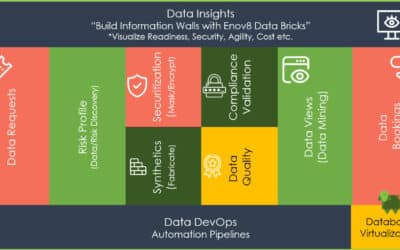
21
APRIL, 2021
by Zulaikha Greer
What Is Privacy by Design?
Millions of dollars go into securing the data and privacy of an organization. Still, malicious attacks, unnecessary third-party access, and other data security issues still prevail. While there is no definite way to completely get rid of such attacks, organizations must find more effective ways to fight these threats. One such method is called privacy by design. This blog discusses the concept of privacy by design and covers the following topics:
- Need for privacy by design
- What is privacy by design?
- Seven principles of privacy by design
- Implementing privacy by design
Need for Privacy by Design
With the ever-growing era of big data, the issues related to data security must be at the forefront of every organization’s framework. Presently, data is the driving force behind most of the tech giants as well as growing start-ups. The benefits of adapting to data-driven approaches are endless. However, the price of such benefits is a threat to the privacy of data.
As organizations indulge in data-driven practices, they share tons of information across different networks within their organization, as well as with other companies. Furthermore, due to the dynamic nature of transferring data between networks, one can find it difficult to keep track of who is accessing, editing, and updating databases. This exposes data to external threats, especially if data is not managed and tracked actively.
For these reasons, organizations must develop a data privacy framework that fits their organizational structure. Privacy by design is an effective process that ensures data security is maintained and practiced at every level within an organization.
What Is Privacy by Design?
Ann Cavoukian, former Information and Privacy Commissioner for the Canadian province of Ontario, proposed the idea of privacy by design (PbD). Formally defined, privacy by design is a framework that embeds privacy and security into each and every structural level of an organization or business project.
Most organizations implement privacy as a separate entity of their organizational structure. It is thought of as an add-on to the existing organizational framework. However, this mindset makes data security and privacy an extension of the existing business framework, rather than a part of it.
If an organization incorporates security protocols from the elementary level of a project, the organization can avoid the risk of a security breach from the very beginning. Conventional data privacy frameworks fail to do so because they do not apply security protocols throughout each level of a business. PbD offers massive benefits because it ensures privacy from the lowest level of a project up until its completion.
7 Principles of Privacy by Design
Privacy by design can be defined through the following seven principles.
1. Proactive, Not Reactive
This principle aims at practicing PbD from the most foundational level of a project. Privacy must be actively (proactively) incorporated and ingrained within the core principles of the organization. By doing so, the organization prepares itself to fight against any security breaches in advance, instead of turning to a third-party specialist after issues arise.
2. Privacy As a Default Setting
It is quite common to see businesses collect customer data through their websites. Such extraction of data must be properly specified and justified to the customer. It is the responsibility of the organization to collect only the type of user data that is necessary. By adhering to policies that prioritize customer data security, an organization can inculcate security and privacy into its culture.
3. Embed Privacy Into Design
As mentioned earlier, one must embed privacy into the structure of an organization and not just perceive it as a mere add-on. By doing this, an organization can maintain security at every level. This reduces the risk of exposing sensitive information to hackers. Moreover, privacy becomes part of the culture of an organization, rather than an additional precautionary measure.
4. Retain Full Functionality (Positive-Sum, Not Zero)
When an organization incorporates privacy into their framework, it must not hinder the functionality of any other process within the framework. This is what retain full functionality means. Again, this has to do with the fact that one must not view privacy as an add-on to the existing framework. Instead find a way to integrate it into the organization in such a way that a fully functional framework emerges.
5. End-to-End Security
As the phrase suggests, end-to-end security dictates that an organization must responsibly secure information from the very onset of data collection until it is no longer needed. This means that an organization must maintain and follow security protocols throughout the entire lifecycle of a business or a project. This comes easily when one integrates security as a part of the organization’s framework.
6. Maintain Visibility and Transparency
This principle ensures that all communication and data related to the implementation of projects, and that involves stakeholders or collaborators, are made available and accessible to them. By allowing stakeholders to actively access and take part in the projects, an organization builds a trustworthy relationship with their stakeholders. Maintaining visibility and transparency is also essential at the customer level. What an organization does with information collected from users must be clearly specified and justified.
7. Respect User Privacy
Respecting user privacy is a persistent issue, especially in the current big data era. With commercial websites both conspicuously and subtly asking for personal data, organizations need to pay more attention to their user privacy protocols. When any organization collects user data, it must clearly specify why, how, and what they do with the data. Furthermore, user must be free to revoke their consent to sharing information if they feel it is unsafe. This not only makes users feel more secure, but it also builds trust with the organization.
Implementing Privacy by Design in Your Organization
To incorporate PbD into your business, you must practice the above principles. Practicing these principles and incorporating them into your organization might be a difficult task, especially if you’re trying to embed PbD into an existing system. PbD may involve remodeling your entire system and incorporating security measures at each step as you rebuild the system.
The first step to establish PbD is to identify the security risks at each level of your system and incorporate relevant measures. Audit your organizational framework for potential vulnerable access points. After identifying the risk points, the next step is to model a framework that protects the organization from privacy attacks. But most importantly, you must maintain and manage the PbD framework. Perform regular audits to check if all parts of your system are secure and function well. Additionally, make sure that your organization actively monitors the kind of user data that it collects. Respecting user privacy is the key to ensuring a trustworthy relationship.
In this post, we covered the basics of PbD and its seven fundamental principles. We also discussed how you can practice PbD in the corporate world. I hope you found it informative. Stay tuned for more
Zulaikha Greer
This post was written by Zulaikha Greer. Zulaikha is a tech enthusiast with expertise in various domains such as data science, ML, and statistics. She enjoys researching cognitive science, marketing, and design. She’s a cat lover by nature who loves to read—you can often find her with a book, enjoying Beethoven’s, Mozart’s, or Vivaldi’s legendary pieces.
Relevant Articles
8 DevOps Anti-Patterns to Avoid
It’s the normal case with software buzzwords that people focus so much on what something is that they forget what it is not. DevOps is no exception. To truly embrace DevOps and cherish what it is, it’s important to comprehend what it isn’t. A plethora...
An Introduction to Application Rationalization
In today's fast-paced digital landscape, organizations often find themselves grappling with a sprawling array of applications. While these applications are crucial for various business operations, the lack of a structured approach to managing them can lead to...
What Makes a Great Test Data Management Tool
What Makes a Great Test Data Management Tool? In today's fast-paced IT landscape, having a robust Test Data Management (TDM) tool is crucial for ensuring quality, compliance, and efficiency in software development and testing. At Enov8, we pride ourselves on providing...
The Top Application Portfolio Management Tools
Managing an application portfolio is essential for organizations aiming to optimize their IT operations, reduce costs, and enhance overall efficiency. Application Portfolio Management (APM) tools are designed to help organizations achieve these goals by providing a...
What Is a Test Data Manager?
Testing is a critical aspect of software development, and it requires the use of appropriate test data to ensure that the software performs optimally. Test data management (TDM) is the process of creating, storing, and managing test data to ensure its quality,...
Sprint Scheduling: A Guide to Your Agile Calendar
Agile sprints can be a powerful, productive and collaborative event if managed properly. However, when neglected or set up incorrectly they risk becoming chaotic and inefficient. Crafting an effective schedule for your sprint is essential to ensure the success of your...









